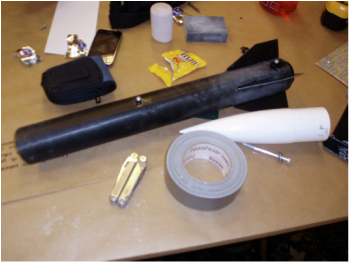|
While at the NASA Robotics Academy this summer, one of the activities we did was attend the Alabama Space Grant Consortium's High-powered Rocketry Workshop. There we learned about the University Student Launch Initiative (USLI) competition and all of the various facets for starting a team and competing. That all sounded like a lot of paperwork, and as everyone there was primarily a robot nerd, were just excited about getting to build big rockets and get National Association of Rocketry (NAR) High-powered Level 1 certifications. We got these really great starter kits by MadCow Rocketry called the Patriot, and had a few days to build and paint them. No one on our team seemed particularly excited about the prospect of painting the rocket, which we believed added little intrinsic value to the rocket other than reduce drag. We felt that we could do better than just build some dumb rocket that went up and came back down. We wanted to do something cool. We wanted to do something different. It was no coincidence that we came to this unanimous conclusion just minutes after the conclusion of a talk by the legendary Tim Pickens. Tim Pickens Has been active in amateur rocketry for about as long as anyone can remember and made himself well known for his daring endeavors, brilliance and quality rocket design. He became the lead propulsion engineer for Space Ship One, developing the hybrid motor that won scaled composites and Virgin Galatic to win the Anasari X-prize. He then went on to start orion propulsion and made a ton of money doing rocket engine design and support for military, NASA, and commercial sectors. Recently (since we have last seen him) He has been leading the Rocket City Space Pioneers in their quest to win the Google Lunar X-prize. He is also well known for his fun and zany home projects, many of which include rocket propulsion. We came to the conclusion that we could put a video camera inside of the rocket and film the ascent and descent . After much shopping and deliberating, we decided to use an Olympus point in shoot that was owned by me (YIKES!). We had our work cut out for us in making this relatively simple project happen. It took many trips to home depot and other stores in Huntsville to find parts that would work well, fit well, and be light enough for our rocket. The most challenging part of this project was planning the assembly as we had to construct the payload bay after we had already assembled the rocket. This required adding another bulk head, camera mounting, keeping the nose-cone securely attached, payload interconnect, another shock cord mount, and hole for the lens. We also needed to create a much more complicated checklist and pre-flight procedures. Luckily our project was a success and we had a safe launch with an H motor. The camera is not really made for shooting video and actually kind of sucks at it. I need to get a better video camera for the next time that I launch this. It also had a difficult time focusing due to the edge of the hole being visible by the camera, and the rapidly spinning terrain. When the parachute charge went off. The camera went black but continued to record sound. We believe this may be from the mechanical shutter closing due to the sudden jerk, but all theories are really just speculation.
Afternoon Delite is in my room right now and is awaiting the spring, when it will fly again.
1 Comment
8/1/2012 09:16:22
This blog is pretty interesting, will add a bookmark, thanks.
Reply
Leave a Reply. |
Lars OsborneBS Mechanical Eng Categories
All
|




 RSS Feed
RSS Feed
